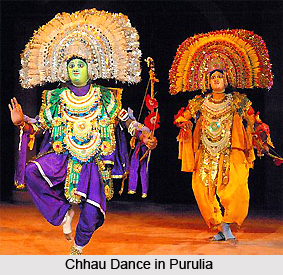 Chhau dance has developed gradually with time. After its beginning and development in Purulia district in West Bengal, it was supported by all feudal Chiefs of the entire Purulia, Ranchi and Singbhum districts. An individual patron had developed the dance according to his own resources and imagination without damaging its basic character. The Raja of Jhalda in Purulia, the Raja of Patkum in Ranchi, the Maharaja of Seraikella in Bihar and the Maharaja of Mayurbhanja in Orissa developed this dance as per their taste. The Maharajas of Seraikella and Mayurbhanja developed it to a great extent as well as introduced its practice among the people of their own States. The members of the family of the Maharaja of Seraikella adopted the practice themselves and the late Maharaja who died at the ripe age of 83 was the last great patron of this dance. It was developed by the family of the Maharajas of Seraikella to such an extent that except some very basic qualities it differed apparently from the parent source.
Chhau dance has developed gradually with time. After its beginning and development in Purulia district in West Bengal, it was supported by all feudal Chiefs of the entire Purulia, Ranchi and Singbhum districts. An individual patron had developed the dance according to his own resources and imagination without damaging its basic character. The Raja of Jhalda in Purulia, the Raja of Patkum in Ranchi, the Maharaja of Seraikella in Bihar and the Maharaja of Mayurbhanja in Orissa developed this dance as per their taste. The Maharajas of Seraikella and Mayurbhanja developed it to a great extent as well as introduced its practice among the people of their own States. The members of the family of the Maharaja of Seraikella adopted the practice themselves and the late Maharaja who died at the ripe age of 83 was the last great patron of this dance. It was developed by the family of the Maharajas of Seraikella to such an extent that except some very basic qualities it differed apparently from the parent source.
The family of the Maharaja of Mayurbhanja was a great patron of Chhau dance once but its members never adopted its practice among themselves. With the integration of the native States with the Indian Union and in consequence thereof the families of both the Maharajas being deprived of their earlier resources, the popularity of Chhau dance in Mayurbhanja and Seraikella has been declining.
However in Purulia where it is being practised by the common people its practice is still being continued by the common men. Within the last 2 or 3 years several troupes have been developed in the villages through the efforts of the most resource less rural people of Purulia.
The Hindu themes had been introduced into it. However a rigid system had been introduced in the same line as of the Indian classical tradition. A new form of masks had replaced the old ones at the same time. In early days the dancers used masks of bamboos and gourds and these dances were related with mythological tales of Mahabharata, Ramayana and the life and nature of human beings. Later on masks made of paper mache were used.
Chhau dance has developed from martial art. It has the merits of `Nritta`. These developments are made in course of time. Chhau dance has not achieved its classical position suddenly. It has its forms according to the regional characteristics. Two other styles were developed from the original style of Chhau Dance: Mayurbhanj style and Seraikella style. In these two styles one find the combination of folk and classical elements.
The present style of Sarakeila Chhau is given to its shape by Kunwar Bijay Pratap Singhdeo in 1920s. He is said to be the Father of Modern Saraikela Chhau. Chhau has covered a long distance from the folk art of `Pharikhanda` to the classical dance.



















